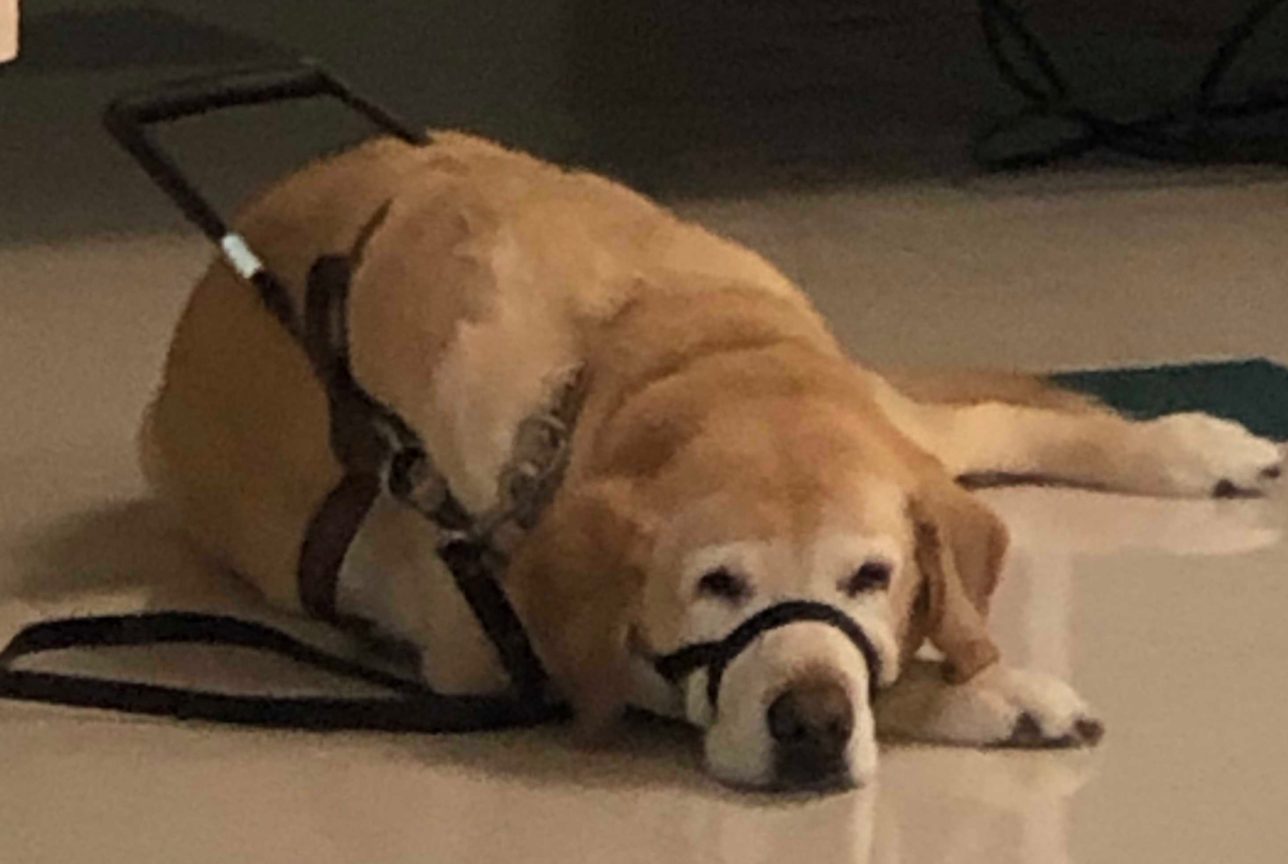From Puppy to Guide Dog

Teamwork – Handler and Guide Dog!
By Christian Puett
September 08, 2019
When you see a dog walking with an individual who is blind, you may wonder how they go from a cute, playful puppy to a valuable partner with a significant job to do. Dog guides or guide dogs are brilliant animals, and only the best are selected for the job. These smart dogs start their training when they are young. During their first year, they live with a family to develop proper social skills and gain exposure to a variety of environments. This foundational training is critical, so the guide dog is prepared to assist a person who is blind or visually impaired.
When puppy raising is complete, they go through a specialized school to learn many commands; i.e., forward, left, right, and find the stairs. When leading their handlers, dog guides perform a vital job. They watch for obstacles and holes in sidewalks or curbs. Guide dogs look for oncoming cars when crossing the street.
A common misconception is that the dog knows when to cross the street. Every decision when using a working guide dog is made as a team. The dog finds the curb; the handler says, “good boy.” The person who is blind listens for traffic, decides when it is safe to cross and says, “forward.” If the street crossing is unsafe, the dog does not move, as if to say, “it is best to wait for now.”
When you see a dog guide in harness, please do not distract the animal. If it is distracted when crossing the street, the person who is blind may be in danger. Please just look and admire the duo, but do not call or pet the dog. These dogs are guiding the individual grasping the harness and need concentration when working.
If the dog is laying on the floor but is still wearing the harness, he is on the job. Whenever the harness is worn, the dog understands it is working and responsible for the safety of the person who is blind. The guide dog is off duty when the harness is not worn. Whether in or out of the harness, please never move, feed, or try to give the dog commands. These dogs have a specific method for care and communication from the trained handler. Consistency is crucial for a successful team. When these procedures are followed, the dog and traveling partner can work safely.
The next time you see a dog walking with an individual who is blind, you can spread the word. Impress your friends and family with what you know about the care, training, and consistency that created a successful working relationship.
Comments (120)
Comments are closed.



wow character slots https://2-free-slots.com/
free caesars slots online https://freeonlneslotmachine.com/
brian christopher slots https://candylandslotmachine.com/
mr cashman slots music https://pennyslotmachines.org/
reel deal slots https://slotmachinesworld.com/
free hot slots https://slotmachinesforum.net/
slots free games https://slot-machine-sale.com/
mr gamez free slots https://beat-slot-machines.com/
scatter slots girls https://download-slot-machines.com/
armor slots https://411slotmachine.com/
bellagio slots guide https://slotmachinegameinfo.com/
online dissertation help https://buydissertationhelp.com/
dissertation writing services in uk https://dissertationwriting-service.com/
dissertation meme https://help-with-dissertations.com/
dissertation defense help https://mydissertationwritinghelp.com/
how long is a dissertation https://dissertations-writing.org/
doctorate degree without dissertation https://helpon-doctoral-dissertations.net/
2hellenic
service writing https://professionaldissertationwriting.org/
dissertation help ireland editing https://professionaldissertationwriting.com/
phd dissertation https://helpwithdissertationwritinglondon.com/
dissertation online help https://dissertationwritingcenter.com/
example of dissertation https://dissertationhelpexpert.com/
acknowledgements dissertation https://accountingdissertationhelp.com/
dissertation writing services reviews https://examplesofdissertation.com/
dissertation research and writing https://writing-a-dissertation.net/
doctoral dissertation writing help https://bestdissertationwritingservice.net/
dissertation introduction https://businessdissertationhelp.com/
dissertation writing services in usa https://writingadissertationproposal.com/
dissertation help https://dissertationhelpspecialist.com/
rutgers dissertation proposal help https://dissertationhelperhub.com/
dissertation cover page https://customthesiswritingservices.com/
online casino sign up bonuses https://download-casino-slots.com/
vegas casino online $100 no deposit bonus codes 2021 https://firstonlinecasino.org/
online casino uk https://onlinecasinofortunes.com/
play casino online https://newlasvegascasinos.com/
online casino fast payout https://trust-online-casino.com/
twin river online casino https://onlinecasinosdirectory.org/
casino online gratis https://9lineslotscasino.com/
casino online betting https://free-online-casinos.net/
casino online games https://internet-casinos-online.net/
online casino software provider https://cybertimeonlinecasino.com/
watch casino full movie free online https://1freeslotscasino.com/
miami casino online https://vrgamescasino.com/
10 dollar minimum deposit usa online casino 2020 https://casino-online-roulette.com/
casino online dinero real usa https://casino-online-jackpot.com/
legit online casino https://onlineplayerscasino.com/
online casino colorado https://ownonlinecasino.com/
casino ohne anmeldung gratis online spielen where
ignition casino online chat https://casino8online.com/
free vpn for laptop https://freevpnconnection.com/
whats the best free vpn https://shiva-vpn.com/
best vpn for computer https://freehostingvpn.com/
free vpn for macbook https://ippowervpn.net/
best free vpn for mobile https://imfreevpn.net/
free fast vpn https://free-vpn-proxy.com/
good vpn free https://rsvpnorthvalley.com/
gay rural men dating site https://gay-singles-dating.com/
gay closet dating https://gayedating.com/
gay dating game https://datinggayservices.com/
single woman dating for free https://onlinedatingbabes.com/
lightdatings life https://adult-singles-online-dating.com/
flirt dating site https://adult-classifieds-online-dating.com/
singles website for farmers https://online-internet-dating.net/
absolutely free dating sites https://speedatingwebsites.com/
sating websites https://datingpersonalsonline.com/
best free date sites https://wowdatingsites.com/
find international singles dating https://lavaonlinedating.com/
new online dating sites https://freeadultdatingpasses.com/
singles ads https://virtual-online-dating-service.com/
spanish dating site free trial https://zonlinedating.com/
sating websites https://onlinedatingservicesecrets.com/
trusted casino online https://onlinecasinos4me.com/
msn games online casino https://online2casino.com/
online keno casino https://casinosonlinex.com/
gay webcam chat sites https://newgaychat.com/
fre gay chat https://gaychatcams.net/
gay roleplay chat https://gaychatspots.com/
gay kink chat https://gay-live-chat.net/
gay adult phone chat https://chatcongays.com/
gay phone chat meet locals “welcome to the https://gayphillychat.com/
gay chat led roulette https://gaychatnorules.com/
gay chat roullette https://gaymusclechatrooms.com/
free chat rooms gay chat https://free-gay-sex-chat.com/
gay sex chat https://gayinteracialchat.com/
chat gay free https://gaymanchatrooms.com/
pay to write papers https://term-paper-help.org/
purchase college papers https://uktermpaperwriters.com/
best custom paper writing service https://paperwritinghq.com/
pay to write papers https://writepapersformoney.com/
custom written college papers https://write-my-paper-for-me.org/
can someone write my paper for me https://doyourpapersonline.com/
help with writing a paper for college https://researchpaperswriting.org/
websites that write papers for you https://cheapcustompaper.org/
paper writing service college https://writingpaperservice.net/
where to buy papers https://buyessaypaperz.com/
custom paper https://mypaperwritinghelp.com/
buy custom paper https://writemypaperquick.com/
best paper writers https://essaybuypaper.com/
need help write my paper https://papercranewritingservices.com/
order a paper online https://premiumpapershelp.com/
paper writer online https://ypaywallpapers.com/
custom paper writing service https://studentpaperhelp.com/
1amanuensis
creative writing coursework https://writingacoursework.com/
coursework writing uk https://mycourseworkhelp.net/
data analysis coursework https://courseworkdownloads.com/
coursework samples https://courseworkinfotest.com/
coursework writing service uk https://coursework-expert.com/
buy coursework online https://buycoursework.org/
coursework https://courseworkdomau.com/
the best online dating site https://freewebdating.net/
datesite https://jewish-dating-online.net/
sexy dating https://free-dating-sites-free-personals.com/
free dating website https://sexanddatingonline.com/
top dating sites in usa https://onlinedatingsurvey.com/
free single personal ads https://onlinedatingsuccessguide.com/
dating free online sites https://onlinedatinghunks.com/
facebook dating site https://datingwebsiteshopper.com/
totally free dating service https://allaboutdatingsites.com/